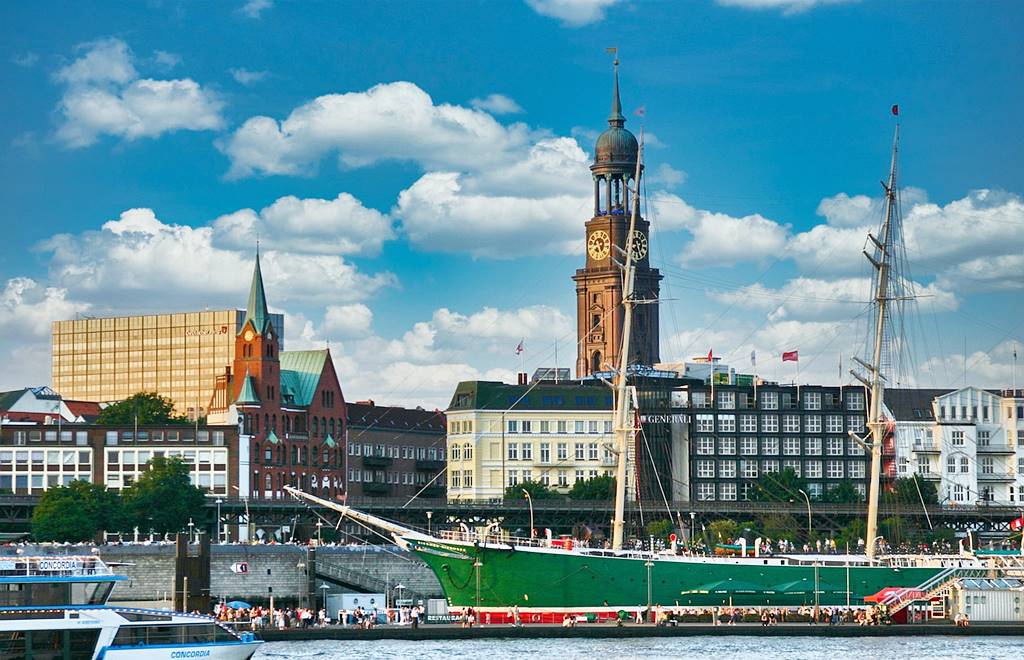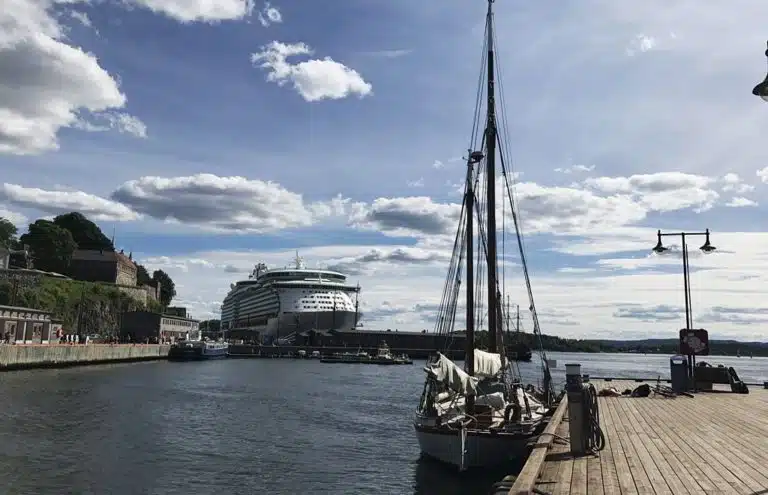Hamburg Cruise Port: A Complete Guide for Cruisers + Top 11 Attractions to Visit
Hamburg is Germany’s largest port city, known for its maritime history, rich culture, and an incredible 2,500+ bridges—more than Venice and Amsterdam combined!
Sitting on the banks of the Elbe River, Hamburg is known as the “‘Gateway to the World” and is home to Europe’s third-largest port.
Hamburg’s cruise port features three terminals: Altona, HafenCity, and Steinwerder, from where you can reach the city’s top landmarks using public transport, or shuttle bus.
This guide covers an overview of Hamburg cruise port and the top 11 things to do and see during your visit.
Hamburg Cruise Port
Hamburg serves as a homeport and turnaround port for several cruise lines, offering three main terminals: Altona, HafenCity and Steinwerder.
Cruise Center Altona
Altona Cruise Terminal welcomes ships up to 300 meters in length and features a modern terminal building with a striking glass front, offering spectacular views of Hamburg’s port.
Visitors can also enjoy a panoramic view from the rooftop terrace.
This terminal is 10-15 minutes by car from the city center and 20-25 minutes by public transport.
The best way to reach Hamburg city center from Altona is by taking the HVV ferry 62 from Dockland pier, located right next to the terminal. The ferry ride takes about 20 minutes and brings you to Landungsbrücken, where you can transfer to the S1 or S3 train or the U3 subway to reach Hamburg Central Station (Hauptbahnhof) and the city center.
Alternatively, bus 111 from Große Elbstraße, just a short walk from the terminal, offers a direct route into the city.
For those who enjoy walking, the scenic Elbe River promenade leads to Landungsbrücken in about 30 minutes.
Cruise Center Steinwerder
The Cruise Center Steinwerder is Hamburg’s most modern cruise terminal that can accommodate the latest and largest cruise ships.
With two separate terminal buildings, it can handle over 8,000 passengers per ship visit and welcomes vessels exceeding 340 meters in length.
As a key docking point for many of the newest cruise ships, Steinwerder offers a smooth embarkation and disembarkation process.
The Cruise Center Steinwerder is located on the southern side of the Elbe River, away from public transport hubs, so getting to the city center requires a combination of shuttle services, taxis, or ferries.
Many cruise lines provide shuttle buses to the city center or Hamburg Central Station (Hauptbahnhof). Check with your cruise line for availability.
A taxi ride to Hamburg Central Station or the city center takes 15-20 minutes, depending on traffic.
To reach Hamburg city center from Steinwerder Cruise Terminal by public transport, walk 15-20 minutes to Argentinienbrücke ferry pier, take HVV ferry 73 to Landungsbrücken, and then transfer to the S1 or S3 train or the U3 subway to reach Hamburg Central Station or other city center stops.
Since Steinwerder is not directly connected to public transport, shuttle buses or taxis are often the best options.
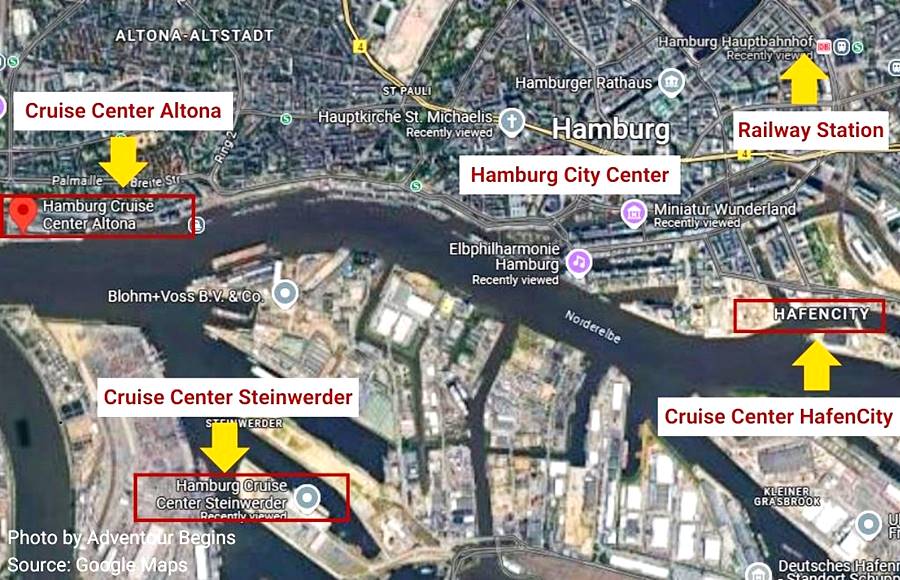
Cruise Center HafenCity
Hamburg’s waterfront has undergone a massive transformation, thanks to one of Europe’s largest urban regeneration projects.
The once-industrial port area has been reimagined as HafenCity, a modern district featuring luxury hotels, shopping centers, restaurants, cultural venues, and residential spaces.
As part of this redevelopment, the new HafenCity Cruise Terminal is currently under construction, set to open in 2025.
This state-of-the-art facility will offer two berths, an underground bus station, parking, taxi access, a hotel, and retail space, placing cruise visitors right in the heart of the city near the Elbphilharmonie and Speicherstadt.
Until the new HafenCity Cruise Terminal opens in 2025, cruise ships are using a temporary terminal at Baakenhöft, located in the eastern part of HafenCity.
If you want to get updated information on Hamburg cruise port and terminals, visit the Port Authority’s official website.
Getting Around Hamburg & Useful Info
- Hamburg is mostly flat, making it easy to explore on foot or by bike.
- Public transport, including buses, trains, and ferries, is wheelchair-friendly, with elevators at major stations and low-floor buses. Many attractions, including museums and shopping centers, are also accessible.
- The best way to get around Hamburg is by using HVV public transport, which includes buses, trains (S-Bahn & U-Bahn), trams, and ferries.
- For unlimited travel and attraction discounts, the Hamburg Card is a great option. It offers free travel on public transport and discounts of up to 50% on museums, musicals, and tourist attractions. It’s available as individual or group tickets for durations ranging from 1 to 5 days. You can purchase the card online, via the “Hamburg – Erleben & Sparen” app, or at various locations throughout the city.
- Bicycles and e-scooters are also widely available for rent, making it easy to explore the city.
- Hamburg Central Station (Hamburg Hauptbahnhof), one of Europe’s busiest railway hubs, is centrally located with direct connections to regional and international trains, as well as the S-Bahn, U-Bahn, and buses.
- Taxis are available throughout the city, and services like Uber and Bolt operate in Hamburg.
- Part of the public transport system, HVV ferries offer scenic routes along the Elbe River.
- Driving is not recommended due to traffic and limited parking in the city center.
- Hamburg experiences mild to warm summers (20-25°C / 68-77°F) and cold, damp winters (0-5°C / 32-41°F), with frequent rain year-round. The best time to visit Hamburg on a cruise is from May to September.
- Hamburg uses the Euro (€) as currency, and credit/debit cards are widely accepted, though cash is useful for smaller purchases; ATMs are widely available throughout the city. For public transport, tickets can be purchased with cash or card at vending machines, ticket offices, or via the Hamburg CARD for unlimited travel.
- The official language is German, but English is widely spoken in tourist areas.
- The Hamburg Hop-on Hop-off Sightseeing Tour offers a flexible way to explore the city aboard a red double-decker bus. With a single-day pass, you can hop on and off at 29 stops, including notable sites like St. Michael’s Church, the St. Pauli Fish Market, and the famous Reeperbahn district. An optional upgrade includes a harbor cruise for a different perspective of Hamburg.
- For first-time visitors, a guided tour is the best way to experience Hamburg’s highlights, including Speicherstadt, the Elbphilharmonie, and St. Michael’s Church, with excursions to the harbor, Reeperbahn, and scenic Alster Lakes. Explore Hamburg tours and activities
Cruising from Hamburg? These Ports Are Often Included in the Itinerary
Cruises that include Hamburg often feature a mix of vibrant cities, scenic fjords, and historic ports across Northern Europe and the British Isles.
The port of Southampton in the UK serves as a gateway to London, while Le Havre offers access to Paris and beautiful Normandy with its historic sites, picturesque cities and iconic Mont Saint Michel.
In Ireland, Cobh is famous for its Titanic history, while Greenock in Scotland provides easy access to Glasgow and the Scottish Highlands, known for their legends, heroes and castles.
The port of Belfast boasts the Titanic Quarter and the stunning Giant’s Causeway, and Liverpool is a must-visit for maritime history and Beatles fans.
Further north, Reykjavik in Iceland offers breathtaking geothermal landscapes and a chance to see the Northern Lights, Golden Circle and the famous Blue Lagoon.
Norwegian ports are also commonly featured, with Alesund known for its Art Nouveau architecture, Bergen as a gateway to the fjords, Olden offering access to the Briksdal Glacier, and Stavanger, home to the iconic Pulpit Rock.
11 Best Things to Do in Hamburg Cruise Port
Whether you have just a few hours or a full day (or two), Hamburg offers a mix of history, culture, and scenic waterfront views. Here are the must-see attractions for cruise visitors:
1. Speicherstadt – The Historic Warehouse District
Speicherstadt is one of the most fascinating places to explore in the city, with its towering red-brick warehouses, winding canals, and over 20 historic bridges.
Built between 1883 and 1927, it’s the world’s largest warehouse district and a UNESCO World Heritage Site, once used to store goods like coffee, tea, and spices.
Today, you can visit top attractions like Miniatur Wunderland, the Hamburg Dungeon, or the International Maritime Museum, or simply stroll through its cobblestone streets and soak in the history.
Even without visiting a museum, it’s worth exploring just for the atmosphere and incredible views—especially when the buildings light up in the evening!
You can also explore Speicherstadt on a boat cruise, gliding through its canals for a different perspective of this historic district.
Explore Speicherstadt tours and activities
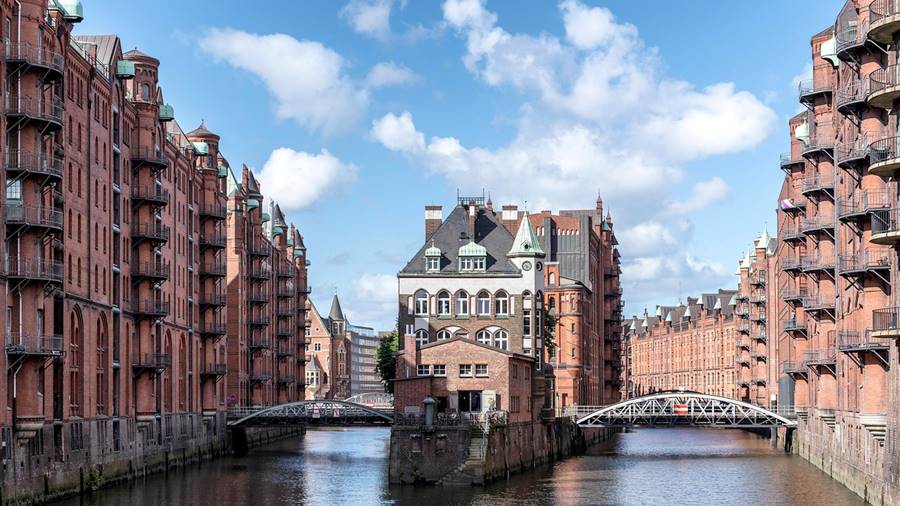
2. Elbphilharmonie – Hamburg’s Iconic Concert Hall
The Elbphilharmonie (Elbe Philharmonic) is one of Hamburg’s most famous landmarks, sitting right on the waterfront in the HafenCity district on the Elbe River.
Opened in 2017, this world-class concert hall was built on top of an old brick warehouse and features two concert halls, as well as a hotel and residential apartments.
Its curved glass facade made of 1,096 individual glass panes reflects the sky and water, and inside, the acoustics are among the best in the world.
Even if you’re not seeing a concert, you can visit the Plaza, a public viewing platform 37 meters (121 feet) high, offering stunning panoramic views of the harbor and city.
Tickets to the Elbphilharmonie Plaza are free, but visitors must book a timed entry slot in advance either online, at the on-site ticket machines, or at the visitor center, with same-day slots subject to availability.
Check out the Elbphilharmonie tours and activities
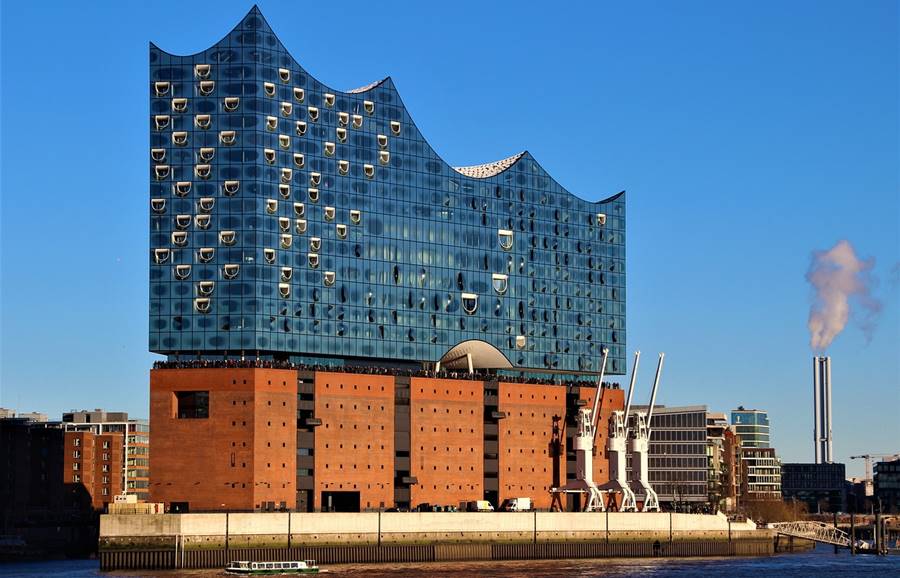
3. Miniatur Wunderland – The World’s Largest Model Railway
Miniatur Wunderland isn’t just for train enthusiasts—it’s one of Hamburg’s most popular attractions for all ages!
Located in Speicherstadt, this massive exhibition features over 16,000 meters (52,500 feet) of model railway tracks, tiny versions of real-world cities, and even an airport where planes “take off” and “land.”
The level of detail is incredible, with moving cars, working lights, and miniature people going about their day.
New sections are constantly being added, and countries like Germany, Switzerland, and Italy are already on display.
Since it’s a top-rated attraction, booking tickets in advance is recommended.
4. St. Michael’s Church (Michel)
Also called Michel, St. Michael’s Church is one of Hamburg’s most important landmarks and a must-visit for history and architecture lovers.
First built in the 17th century, this Baroque-style church has been rebuilt multiple times, most recently after World War II.
Its 132-meter (433-foot) tower is one of the best viewpoints in the city, offering a stunning 360-degree panorama of Hamburg and the harbor. You can either climb 452 steps to the top or take the elevator.
Inside, the church features a beautiful white and gold interior, and the crypt below holds centuries of history.
Check out St. Michael’s Church tours

5. Landungsbrücken & The Port of Hamburg
Hamburg’s Landungsbrücken is the heart of its historic harbor and one of the best spots to soak in the city’s maritime atmosphere.
Located along the Elbe River, this lively waterfront area is home to ferry terminals, floating docks, seafood restaurants, and harbor cruises.
From here, you can hop on a public ferry (HVV 62) for a budget-friendly cruise past massive container ships, historic sailing vessels, and the impressive Elbphilharmonie.
Landungsbrücken is also the starting point for boat tours to the Elbe Tunnel, the bustling port, and the nearby Fischmarkt, which comes alive every Sunday morning.
Explore Landungsbrücken tours and activities
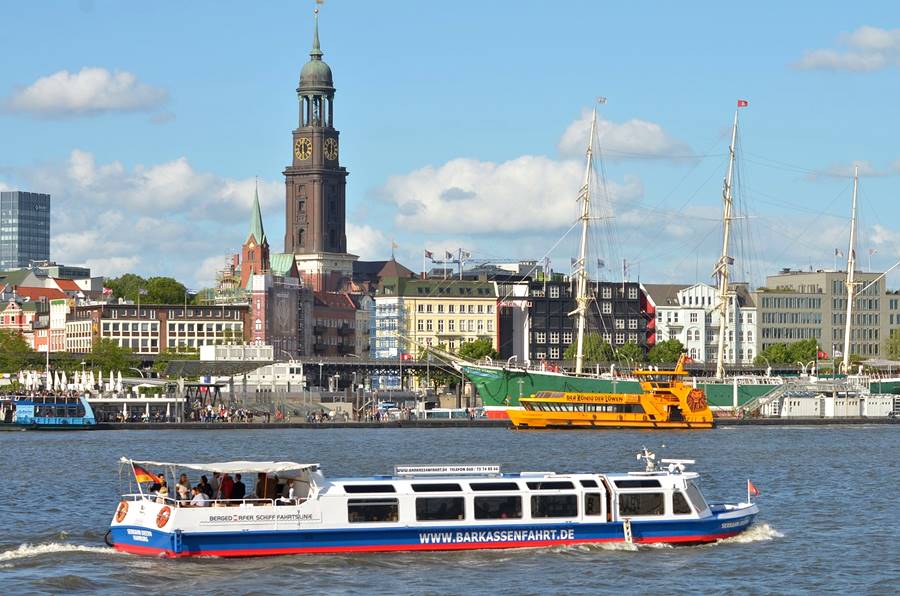
6. Reeperbahn – Hamburg’s Famous Entertainment District
The Reeperbahn is one of Hamburg’s most famous streets, known for its nightlife, theaters, and music history.
Located in the St. Pauli district, this area is packed with clubs, bars, and concert venues, making it one of Europe’s most vibrant entertainment hubs.
It’s also where The Beatles played before they became famous, and you can visit places like the Indra Club and Star-Club memorial to see where they got their start.
While some parts of the Reeperbahn are known for their red-light district, it’s also home to live music, comedy shows, and even guided Beatles-themed walking tours.
Explore Reeperbahn tours and activities
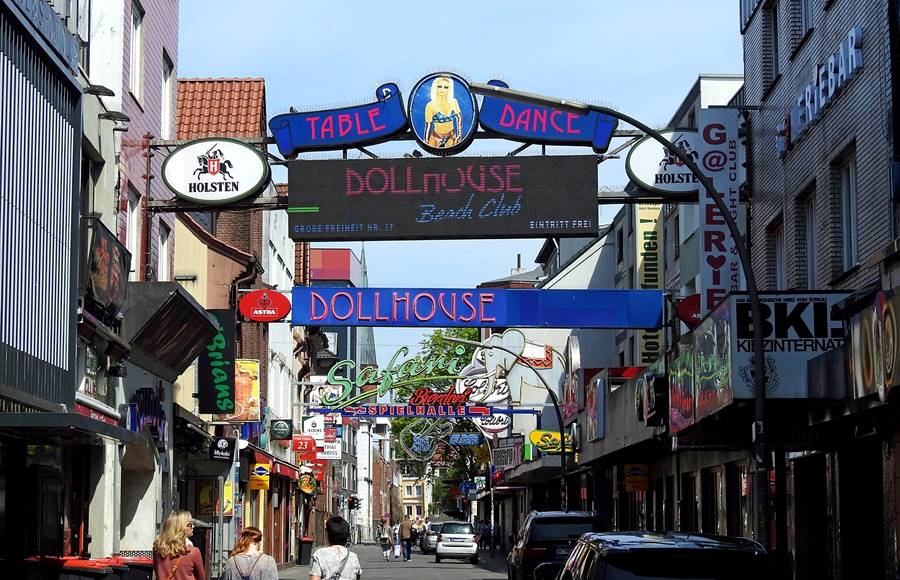
7. Rathaus (City Hall) & Historic Old Town
Hamburg’s Rathaus (City Hall) is one of the city’s most impressive landmarks, standing in the heart of the Old Town with its ornate Neo-Renaissance facade and towering 112-meter (367-foot) spire.
Completed in 1897, the building has 647 rooms, more than Buckingham Palace, and serves as the seat of Hamburg’s government.
You can admire its detailed sandstone exterior, explore the grand courtyard with its Hygieia Fountain, or take a guided tour inside to see its lavish halls and historic chambers.
Surrounding the Rathaus, Hamburg’s Old Town (Altstadt) is a great area to wander, with a mix of historic buildings, shopping streets like Mönckebergstraße, and cozy cafés perfect for soaking in the city’s atmosphere.
Explore the Hamburg Old Town on a guided tour
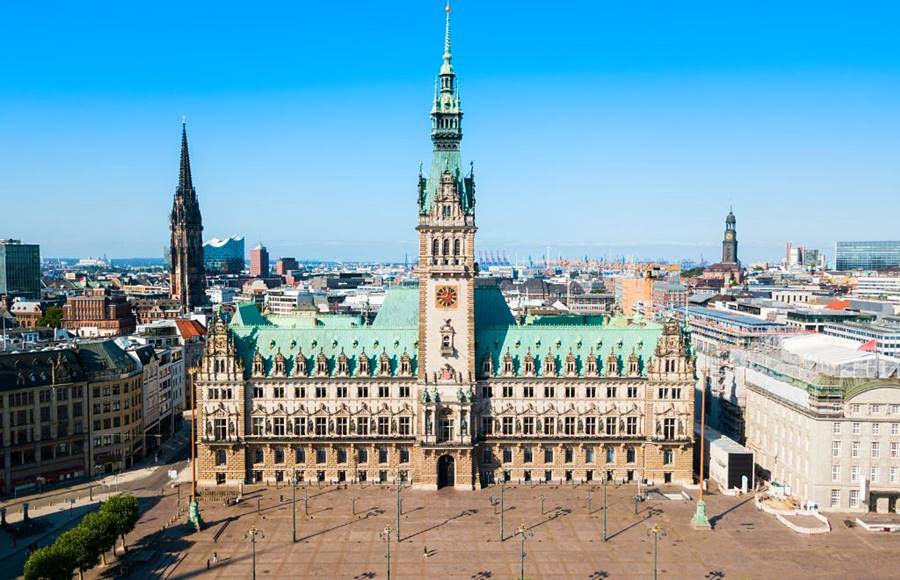
8. Fish Market (Fischmarkt)
If you’re visiting Hamburg on sunday, Fish Market (Fischmarkt) is a must-visit!
This Hamburg’s morning tradition attracts both locals and tourists with its fresh seafood, bustling atmosphere, and live music.
Dating back to 1703, this lively market opens at sunrise (5:00 AM in summer, 7:00 AM in winter) and runs until 9:30 AM, making it a perfect early stop if your cruise arrives in the morning.
Located near Landungsbrücken, the market offers everything from fresh fish, fruit, and flowers to unique souvenirs.
Inside the historic Fish Auction Hall, you’ll find a lively scene with live bands playing rock and jazz as visitors enjoy traditional Hamburg specialties like a Fischbrötchen (fish sandwich).
Whether you’re there for the food, the music, or just the experience, the Fischmarkt is one of the city’s most authentic spots!
9. Lübeck – A Medieval Hanseatic City
If you have time for a day trip, Lübeck is one of the best excursions from Hamburg.
Just an hour away, this UNESCO-listed city is famous for its medieval Old Town, narrow cobblestone streets, and stunning red-brick buildings.
The Holstentor Gate, one of Lübeck’s most iconic sights, once protected the city in the Middle Ages.
Lübeck was also the leading city of the Hanseatic League, a powerful medieval trade alliance that connected port cities across Northern Europe, shaping the region’s economy and architecture.
The city is also known for its marzipan, and a visit to Café Niederegger—one of the best places to try this sweet treat—is a must.
With its well-preserved architecture and historic charm, Lübeck is a great place to step back in time.
Check out Lübeck tours from Hamburg
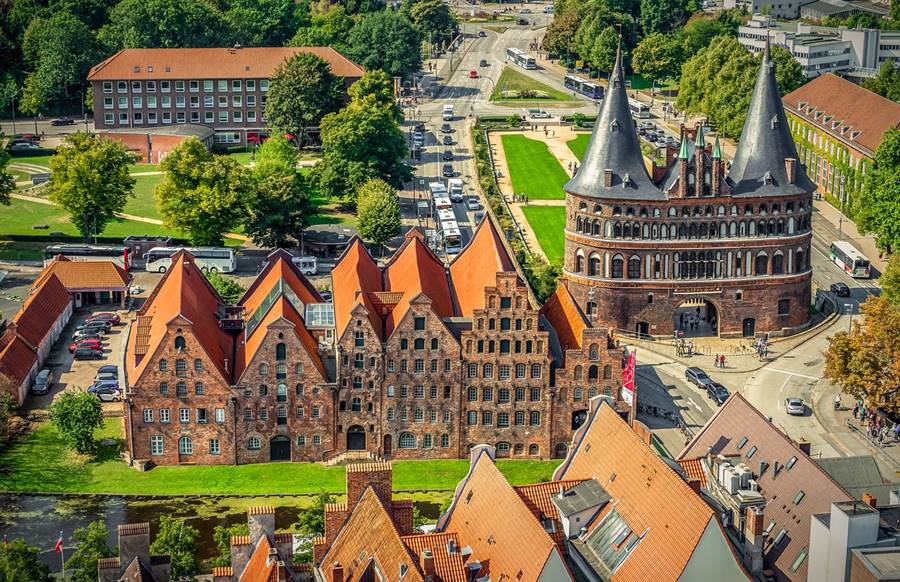
10. Bremen – A Historic City of Trade and Legends
About 90 minutes’ drive southwest of Hamburg, Bremen is another fantastic day trip, is a city known for its rich maritime history, medieval architecture, and connection to the Brothers Grimm fairy tale, “The Bremen Town Musicians.”
As one of the oldest Hanseatic cities, Bremen is home to the UNESCO-listed Town Hall, the Roland Statue, and the famous Bremen Town Musicians statue from the Brothers Grimm fairy tale.
The Schnoor Quarter, with its medieval alleyways and half-timbered houses, is perfect for a scenic stroll.
Bremen is smaller than Hamburg but packed with history, and you can visit it on a guided tour or by train.
Check out Bremen tours from Hamburg
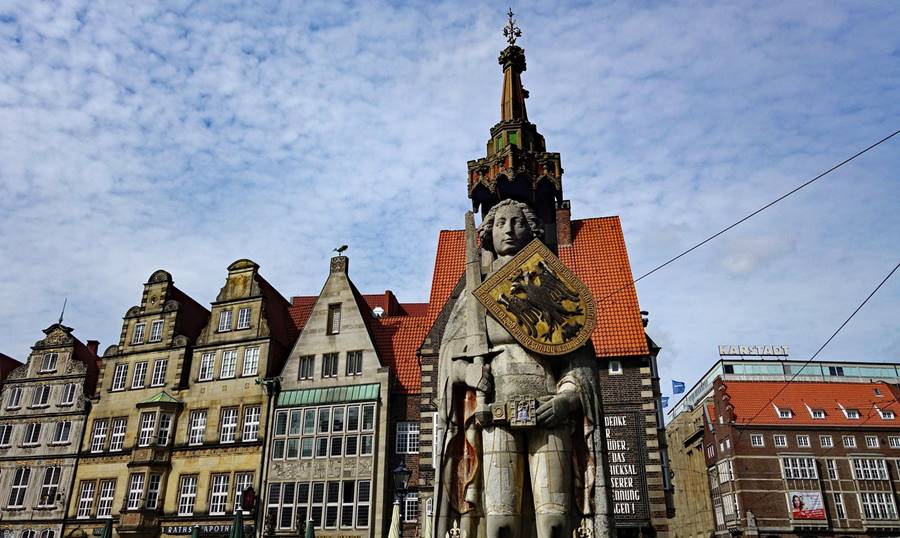
11. Berlin – Germany’s Capital
Although Berlin is about 2.5 hours from Hamburg, it remains one of the most popular shore excursions for visitors looking to explore Germany’s capital.
A city rich in history, Berlin is home to iconic landmarks like the Brandenburg Gate, the Reichstag (Parliament Building), and remnants of the Berlin Wall, including the famous East Side Gallery.
History enthusiasts can visit the Memorial to the Murdered Jews of Europe or Checkpoint Charlie, while culture lovers can explore Museum Island, a UNESCO-listed complex of world-class museums.
Berlin also boasts a thriving arts and culinary scene, with plenty of cafés, beer gardens, and street food stalls offering local favorites like Currywurst and Döner kebabs.
Although it’s a longer journey, you can visit Berlin on a guided tour or independently by taking a direct train from Hamburg Central Station.
Check out the tours and transfers from Hamburg to Berlin
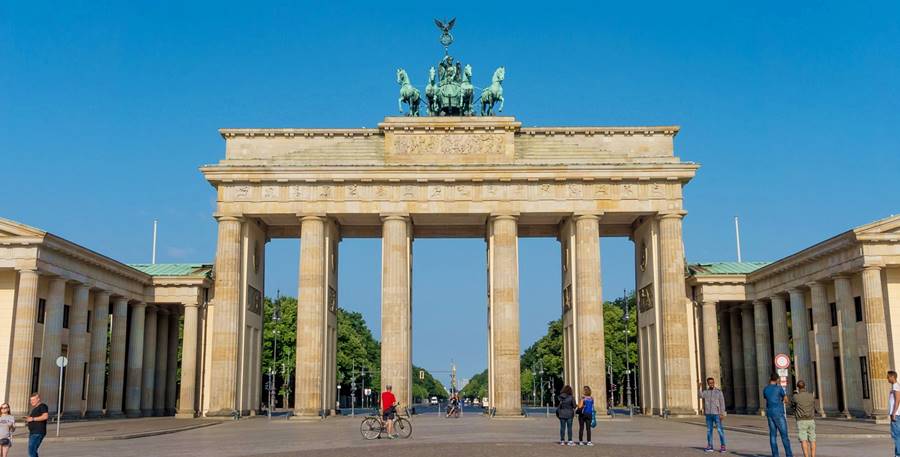
To Wrap Up
Whether you’re exploring its historic warehouse district, admiring the views from the Elbphilharmonie, or venturing to nearby cities like Lübeck or Bremen, there’s something for every traveler.
With its efficient public transport, scenic waterfront, and rich Hanseatic heritage, Hamburg is both easy to explore and full of amazing experiences! Have a wonderful cruise! 🙂
You may also like our cruise port guides to the Mediterranean, Caribbean, Northern Europe, USA & Canada, Australia & New Zealand
Adventour Begins contains affiliate links. If you make a purchase through these links, we may earn a commission at no additional cost to you. For more details, please see our Disclosure Policy

